A delicate, fluffy sponge adorned with whipped cream, lemon curd and fresh raspberries
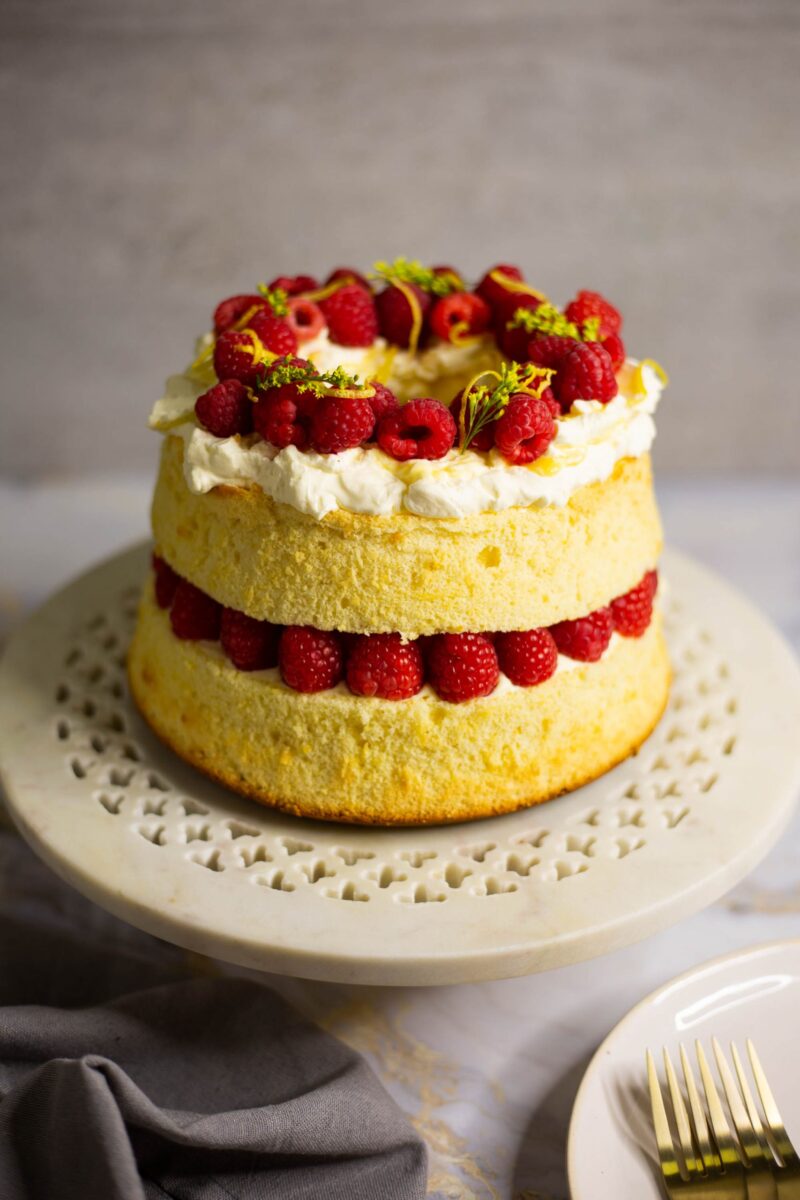
This is my first blog post for 2022 and I am looking forward to the new year. Last year was not an easy one, with the loss of a loved one and an extremely challenging work environment, but I pray for better days. What will remain a constant in my life is baking and trying out different recipes and with that I am excited to share my first recipe for the year with you all.
Have you ever heard of a chiffon cake? It is an incredibly lofty sponge cake, which is made by folding whipped egg whites into a cake batter – it is typically therefore classified into the category of ‘foam cakes’. Unlike many cakes which use butter as the fat, this cake uses vegetable oil, which does not firm up at room temperature – this keeps the cake soft and spongy, and also results in an incredibly tender crumb.
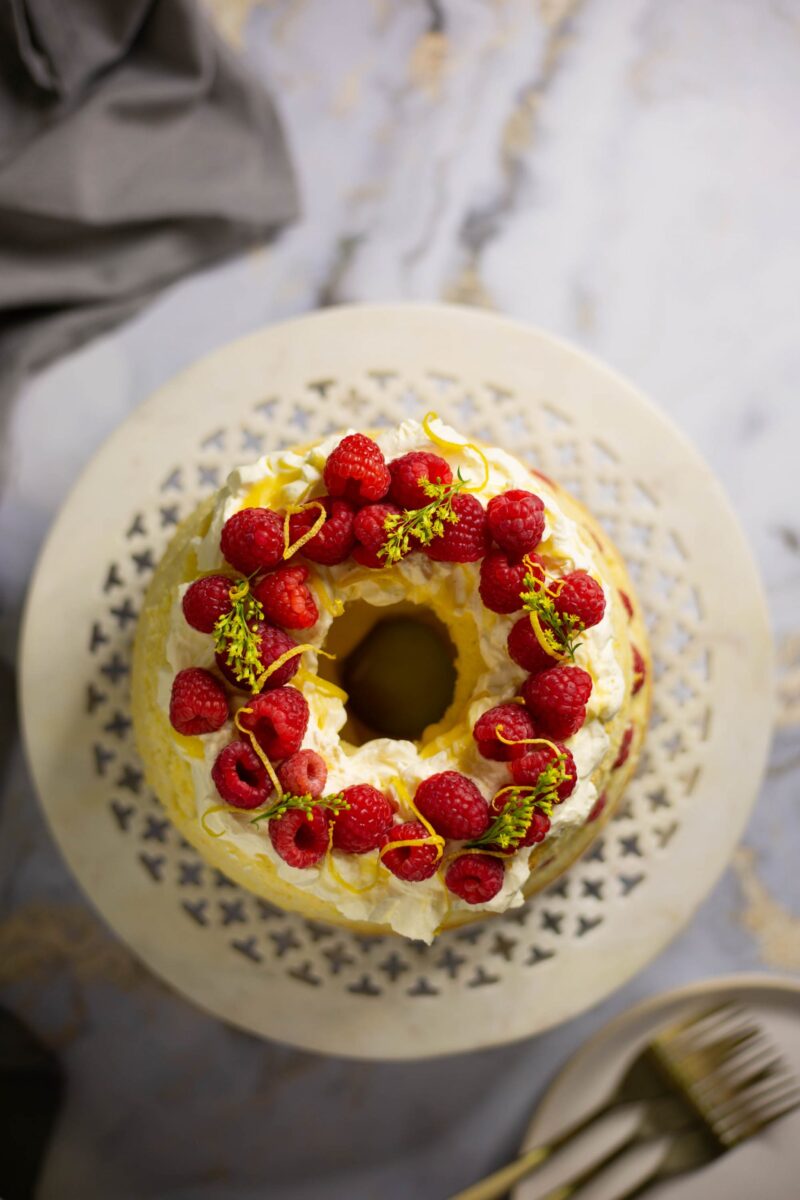
When I first tasted a chiffon cake, I found the flavour to be rather nondescript – the oil lends wonderful moistness but little by way of flavour, in comparison to a butter cake. What this does do, however is provide a wonderful base to add flavour through different toppings. I’ve chose to stick with safe but winning flavours here. A light lemon sponge, with slightly sweetened whipped cream, tangy lemon curd and tart raspberries.
Whilst i love the contrast of the red raspberries on the yellow sponge, you could use strawberries, blueberries, blackberries or even fresh cherries, when in season. At the risk of sounding redundant, I always encourage you all to have creative license with certain aspects of a recipe like decorating, styling and tweaking flavour profiles – make it your own! That being said, remember that baking is a science, and so before you decide to make structural changes (like reducing the sugar, because you find a recipe too sweet) make sure you test the recipe in its original state before beginning to tweak it.
You do require a special tin in order to make this cake – an angel food/chiffon cake tin. The tin has several important functions:
- The tube base is removable from the rest of the tin, so that the cake can be easily released post baking. This is even more important, because this tin should not be lined with anything.
- Because there is so much batter in the tin, the tube in the middle helps to conduct heat and ensure that the center of the cake bakes evenly,
- The cake tin has little ‘feet’. This is because, once baked, the cake needs to cool upside down, to prevent the sponge from collapsing on itself.
I bake this cake in a 20cm chiffon cake tin, which you can purchase from Takealot. I also own a 24cm chiffon cake tin because I do a lot of baking, and so I have tested this in a large cake tin, by adjusting the recipe proportions. I share the information on how to bake it in a bigger tin, in the recipe, should that be all that you have.
The styling of this cake was inspired by a recipe from My Sweet Life by Fiaza Omar.


OTHER RECIPES YOU MAY ENJOY
If you have invested in a chiffon cake tin, then these other cakes are ideal to be baked in a similar way:
If you love the pairing of lemon and berries, then you may also like these recipes:
- Lemon, Raspberry and Almond Loaf (Gluten-free)
- Lemon, Rose and Rasberry Cake with White Chocolate Labneh Ganache
- Lemon and Blueberry Cake
- Lemon and Blueberry Loaf
- Lemon and Blueberry Cheesecake
INGREDIENTS FOR MAKING THIS LEMON CURD AND RASPBERRY CHIFFON CAKE
Cake Flour – ensure that you use a good quality cake flour, which has a lower protein content than white bread flour. This ensures a soft and tender crumb.
Caster Sugar – usually, with minor change in results you can get away using granulated sugar in other cakes. The fine crystal structure of the caster sugar is particularly important to ensure that the sugar dissolves into the egg whites, so use this for optimal success.
Lemons – the zest and juice of a lemon is needed. Use the juice from freshly squeezed lemons and not a bottle, please. It is easier to zest the lemon first, before squeezing it.
Sunflower oil – use a neutrally flavoured oil, so that the overall flavour of the bake is not impacted.
Eggs – both the egg yolks and whites are used in this cake, but seperately. So be sure to seperate them and ensure that no yolk gets into the white. A bit of white with the yolks is less of an issue. In South Africa, a large egg white weighs about 30g and a yolk about 15g – 18g.
Whipping Cream – regular fresh cream can work took, but for stiffer peaks that can work well as a filling between layers, a firm cream is preferred.
Icing Sugar – ensure it is sifted and fine, so that there are no unexpected lumps in the whipped cream.
Lemon Curd – bright, zesty and tangy – you can obviously make your own lemon curd, but store-bought works too.
Fresh Raspberries – try to buy these closer to the time of assembly, as they do not last for many days.
TIPS FOR MAKING THIS LEMON CURD AND RASPBERRY CHIFFON CAKE
- Where can I buy an angel food cake/ chiffon cake tin? Various specialty baking shops will stock this type of tin, which has feet for cooling the cake upside down. If you are in South Africa, you can purchase one here.
- Why should I not line the cake tin? Usually, one of the first steps in baking is to grease and line your cake tins. With a chiffon cake however, you want the cake to cling to the sides of the tin as it rises, and greasing the tin will prevent that.
- What is the purpose of the lemon juice when whipping the egg whites? The lemon juice helps to stabilize the egg whites, so that they whip up better. If you do not have lemon juice, use a teaspoon of cream of tartar or a teaspoon of vinegar.
- Why do you cool the cake upside down? The tin is specifically designed to allow the cake to cool upside down, as it has feet. This helps to prevent the cake on collapsing on itself when it comes out of the oven.
- Can you freeze the cake? The cake can be frozen for up to a month, however it will lose some of its lightness.
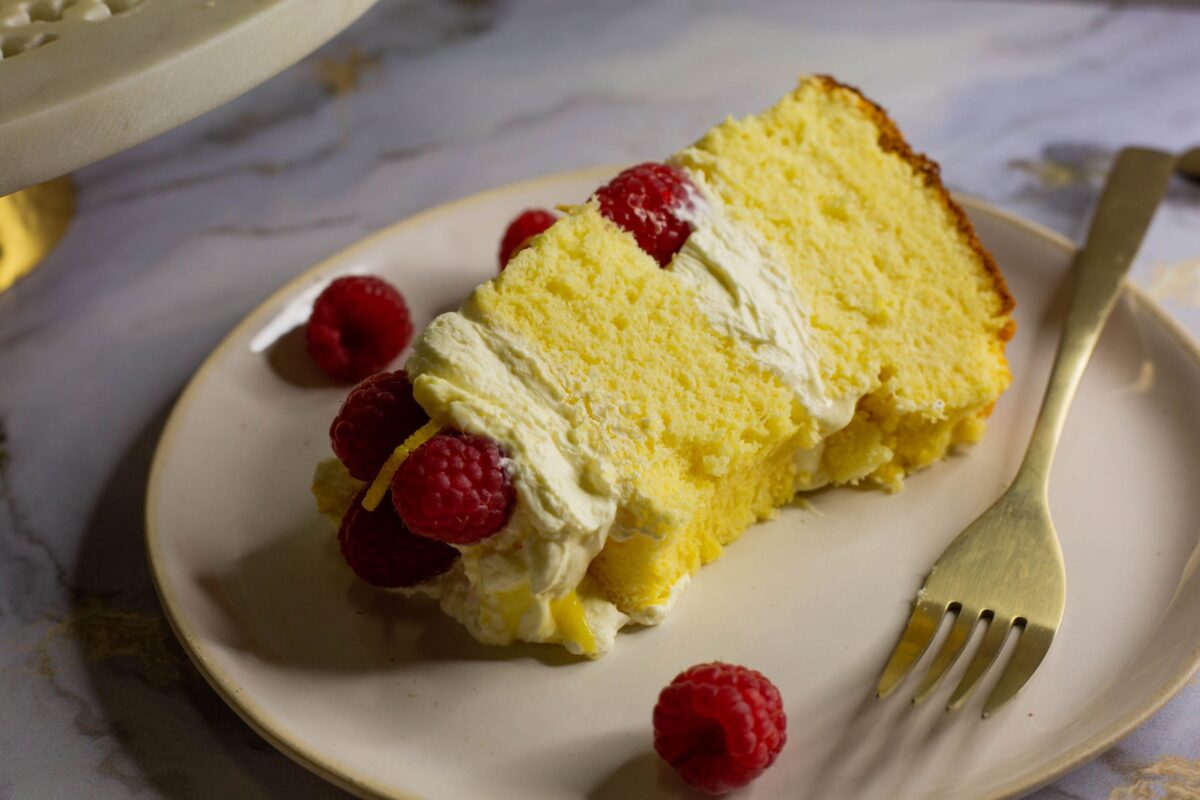
If you make this recipe, please share it with me by tagging me on Instagram @adventureswithsugar or on Facebook at Adventures with Sugar.
FOR THE LEMON CURD AND RASPBERRY CHIFFON CAKE
The original cake was designed to bake in a 20cm chiffon cake tin, but I have included the quantities for a 24cm chiffon cake tin in brackets.
- 170g cake flour (225g cake flour)
- 2 1/4 teaspoon baking powder (3 teaspoons baking powder)
- 1/4 teaspoon salt (1/2 teaspoon salt)
- 240g caster sugar, divided 200g and 40g (300g caster sugar, divided 240g and 60g)
- 1 tablespoon of lemon zest
- 60ml lemon juice, plus 5ml for the egg whites. (80ml lemon juice, plus 5ml for the egg whites)
- 70ml water (60ml water)
- 90ml sunflower oil (125ml sunflower oil)
- 6 large egg yolks (8 large egg yolks)
- 7 large egg whites (9 large egg whites)
METHOD
- Prepare your tins and heat your oven – Preheat the oven to 180 degrees Celcius. Do not grease your 20cm angel food cake tin. Make sure the tin is clean and free from any grease.
- Prepare the dry ingredients – In a medium bowl, sift the cake flour, baking powder and salt and set aside. Add in 200g (240g if using a 24cm cake tin) sugar into the flour mixture.
- Prepare the wet ingredients – In a medium jug, mix 60ml lemon juice (80ml if using a 24cm tin), water, oil and only egg yolks together.
- Combine the wet and dry ingredients – add the wet ingredients to the dry ingredients and mix with a hand-held whisk until just combined.
- Prepare the egg whites – In a clean (ideally glass or steel) mixing bowl, add in the egg whites. Using the beater attachment of an electric whisk or stand mixer, whip the egg whites until it begins to get frothy and foamy, but no peaks have begun to form. Then add the 1 teaspoon of lemon juice and whip until soft peaks form.
- Add the remaining sugar to the egg whites – Gradually add in the 40g of sugar (60g if making a 24cm), a tablespoon at a time. Ensure that the tablespoon is well dissolved before adding the next, until you have stiff, glossy peaks.
- Add the meringue to the rest of the cake mixture – Using a rubber spatula or metal spoon, fold by hand the meringue into the rest of the cake batter, being careful not to knock out too much air.
- Bake the cake – Pour the mixture into the ungreased cake tin and bake for 35 – 40 minutes (45 – 55 minutes if using a 24cm tin), or until a skewer inserted comes out clean.
- Allow the cake to cool before decorating – Once the cake is out of the oven, invert the cake tin and cool the cake upside down.
TO ASSEMBLE THE LEMON CURD AND RASPBERRY CHIFFON CAKE
- 400ml whipping cream (500ml whipping cream)
- 2 tablespoons icing sugar (2 tablespoons icing sugar)
- 120g lemon curd (150g lemon curd)
- 320g fresh raspberries (500g fresh raspberries)
- fresh lemon zest and fresh edible flowers, to decorate
METHOD
- Prepare the cooled cake – Remove the cake from the cake tin and slice the cake in half.
- Prepare the cream – Beat the cream until soft peaks form, then add in the icing sugar and continue to beat until stiff peaks form.
- Assemble the cake – Add half the cream to the bottom half of the cake. Leave some space just before the outer edge, as that is for the raspberries to go. Then swirl in half the lemon curd. Place the raspberries in a single file around the outer rim of the cake.
- Finish off the cake – Then place the second half of the cake on the first half. Repeat the process with the remaining cream and lemon curd, and pile with more raspberries and edible flowers if you like.
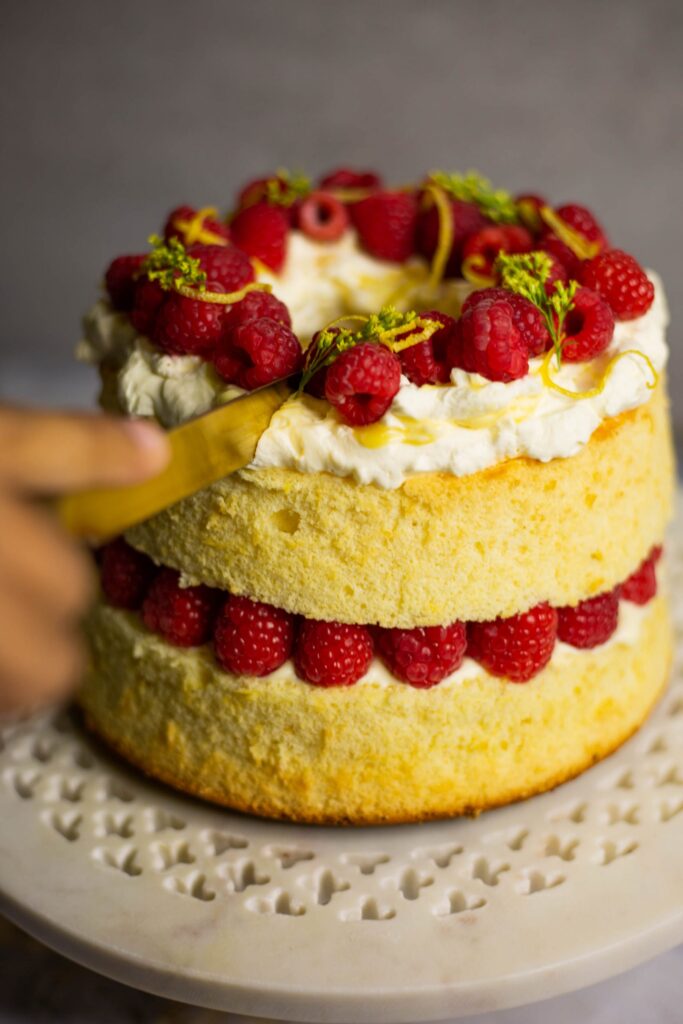
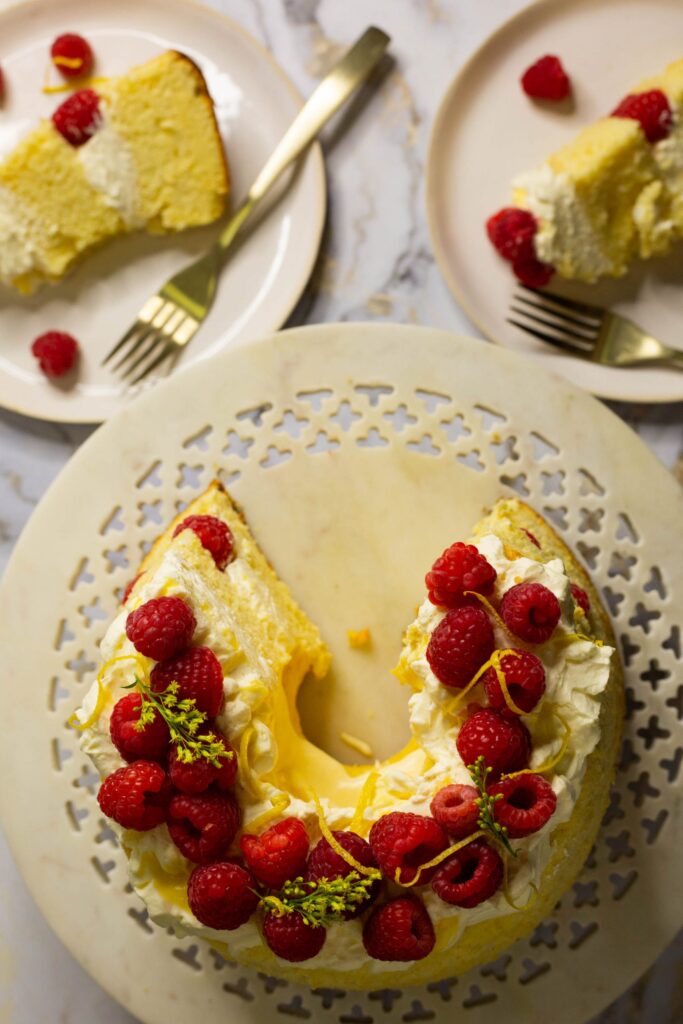
Recipe by adventureswithsugar.com




1 Comment
Gluten-free Almond, Raspberry and Lemon Loaf – Adventures with Sugar
4 January, 2022 at 10:35 am[…] I often have leftover fruit, from other baking adventures, which I need to use up. Here, there were left over lemons and raspberries from my lemon curd and raspberry chiffon cake. […]